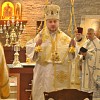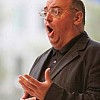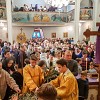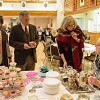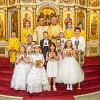Pentecost Trinity Sunday fell on Sunday June 23. Upon dismissal of the Liturgy, Vespers with Kneeling Prayers were held. This was then followed by a blessing of recently re-finished icons.
Pentecost (also called Trinity Day or Descent of the Holy Spirit) is one of the Great Feasts of the Orthodox Church, celebrated fifty days after Pascha (thus always falling on a Sunday). Fifty days after the Resurrection, on the excising Jewish feast of Pentecost, while the disciples and many other followers of Jesus Christ were gathered together to pray, the Holy Spirit descended upon them in the form of "cloven tongues of fire," with the sound of a mighty rushing wind, and they began to speak in languages that they did not know. There were many visitors from the Jewish diaspora to Jerusalem at that time for the Jewish observance of the feast, and they were astonished to hear these untaught fisherman speaking praises to God in their alien tongues. This account is detailed in the Acts of the Apostles, chapter 2. The number fifty, as in the fiftieth day after Pascha, stands for eternal and heavenly fulfillment, seven times seven, plus one.
The Orthodox Church sees Pentecost as the final fulfillment of the mission of Jesus Christ and the first beginning of the messianic age of the Kingdom of God, mystically present in his Church. It is traditionally called the beginning of the One Holy Catholic and Apostolic Church. Besides celebrating the coming of the Holy Spirit, the feast also celebrates the full revelation of the divine Trinity, Father, Son, and Holy Spirit. Hymns of the Church, celebrate the sign of the final act of God's self-disclosure to the world of His creation. To Orthodox Christians, the feast of Pentecost is not just a celebration of an event in history. It is also a celebration their membership in the Church. They have lived Pentecost and received "the seal of the gift of the Holy Spirit" in the sacrament of chrismation. For the feast of Pentecost the icon of the Holy Trinity, the three angelic figures who appeared to Abraham, is placed in the center of the church for veneration. This icon is used with the traditional Pentecost icon. The church building is decorated with flowers and the green leaves of the summer to show that God's divine breath comes to renew all creation. Green vestments and coverings are also used. In many parishes the feast is celebrated starting the evening before with Great Vespers. Some parishes also serve Matins on the morning of the feast before the Divine Liturgy. The Liturgy of Saint John Chrysostom with special hymns replacing the standard Antiphons. The hymns O Heavenly King and We have seen the True Light are sung for the first time since Easter, calling the Holy Spirit to "come and abide in us," and proclaiming that "we have received the heavenly Spirit." The Great Vespers of Pentecost (Sunday) evening features three long prayers at which the faithful kneel for the first time since Pascha. Many smaller parishes have this service immediately following the liturgy. The Monday after Pentecost is the Feast of the Holy Spirit in the Orthodox Church, and the Sunday after Pentecost is the Feast of All Saints.
Even though the start of the church year is considered to start in September, the liturgical center of the annual cycle of Orthodox worship is the feast of Pascha, preceded by Great Lent, and pre-lent, and followed by the fifty days of paschal celebration until the feast of Pentecost. Until the start of the next Great Lent, the Sundays and weeks following Pentecost, are numbered from Pentecost. Liturgical readings and hymns will be based on the "weeks after Pentecost" as listed in the Octoechos, Apostolos, and Lectionary arranged Gospel.
Після вознесіння Ісуса Христа настав десятий день: це був п’ятдесятий день після Воскресіння Христового. У євреїв було велике свято П’ятидесятниці в пам’ять Синайського законодавства. Всі апостоли разом із іншими учнями Христовими та іншими віруючими одностайно перебували в одній світлиці в Єрусалимі. Була третя година дня за єврейським рахунком годин, тобто, по-нашому — дев’ята година ранку.
Раптом зчинився шум з неба, ніби буря раптова зірвалася, і переповнила ввесь той дім, де перебували учні Христові. І з’явилися вогненні язики і спочили (зупинилися) по одному на кожному з них. Всі сповнилися Духа Святого і стали славити Бога різними мовами, яких раніше не знали. Так Дух Святий, за обітницею Спасителя, зійшов на апостолів у вигляді вогненних язиків, на знак того, що Він дав апостолам здатність і силу для проповіді Христового вчення всім народам; зійшов же у вигляді вогню на знак того, що має силу спалювати гріхи й очищати , освячувати й зігрівати душі.
В Єрусалимі в цей час було багато євреїв, які прийшли з різних країн на свято. Апостоли вийшли до них і стали проповідувати на їхніх рідних мовах про воскреслого Христа. Проповідь так подіяла на тих, хто слухав її, що багато хто повірив і стали питати: «Що ж нам робити?» Петро відповів їм: «Покайтеся і хрестіться в ім’я Ісуса Христа на прощення ваших гріхів, тоді і ви отримаєте дар Святого Духа».
Таких, що увірували в Христа і охоче прийняли хрещення, виявилося того дня близько трьох тисяч чоловік. Таким чином, почало будуватися на землі Царство Боже, тобто Церква Христова. Православні християни в цей день прикрашають будинки і храми зеленими гілочками, квітами. Звичай цей іде ще від старозавітної Церкви, коли в П’ятидесятницю будинки і синагоги прикрашалися зеленню на пам’ять про те, як при Синайській горі все цвіло і зеленіло в день, коли Мойсей отримував скрижалі закону. Сіонська світлиця, де на апостолів зійшов Святий Дух, у той час, за загальним звичаєм, теж була прикрашена гілками дерев і квітами. А ще квітучі гілки нагадують нам про те, що під дією благодаті Божої людські душі розцвітають плодами чеснот.
|
| |||||||||||||


